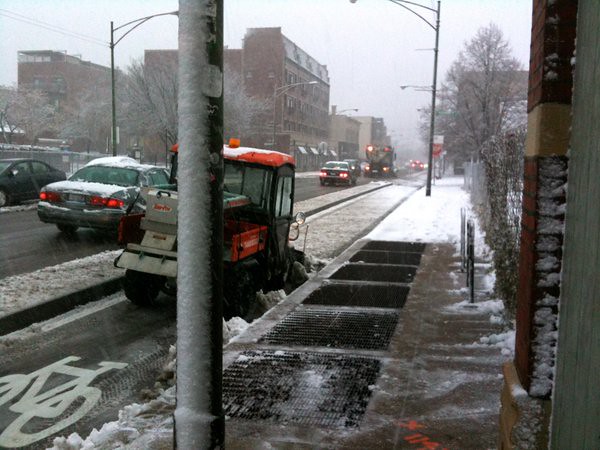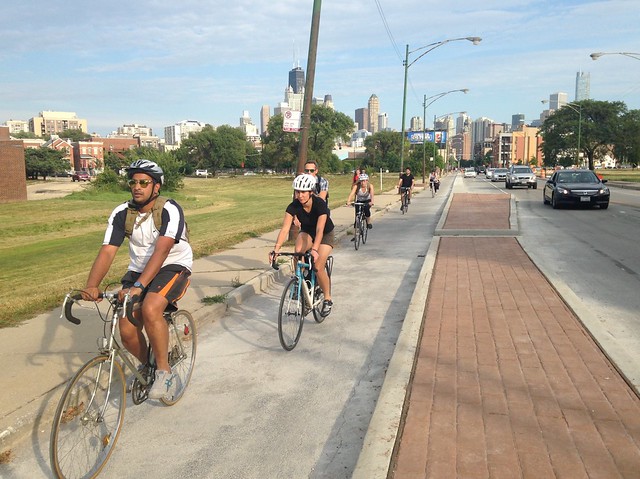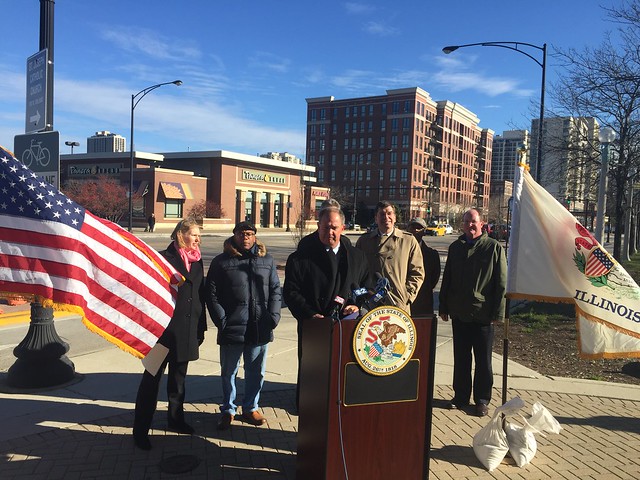The ribbon cutting for the Clybourn Avenue curb-protected bike lanes in Old Town on November 20 was a Kumbaya moment for the city and state transportation departments after years of conflict over protected lanes.
Soon after Chicago Department of Transportation opened the city’s first protect lane on Kinzie Street in July 201 the Illinois Department of Transportation began quietly blocking CDOT from installing protected bike lanes on state routes within the city. After Streetsblog’s Steven Vance broke the story of the ban in February 2013, IDOT claimed they needed three years of safety data on existing Chicago protected lanes.
The former heads of CDOT and IDOT have recently indicated that ex-governor Pat Quinn’s deputy chief of staff Sean O’Shea was the driving force behind the prohibition. Former city transportation chief Gabe Klein said the ban was actually motivated by “political and personality issues.”
After the ban was made public, the Active Transportation Alliance rallied supporters to send 3,000 emails to Quinn asking him to overturn it. The advocacy group also enlisted a coalition of business leaders to lobby the governor, including a meeting between the leaders and O’Shea.
These efforts, along with the outcry following the May 2013 crash on Clybourn that took the life of cyclist Bobby Cann, led the state to change its position on protected lanes. They agreed to build the curb-protected lane on Clybourn, a state route, as a pilot project, in cooperation with CDOT.
The lanes, which are separated from moving traffic by wide curbs, run on Clybourn between North Avenue and Division Street, and on Division from Clybourn to Orleans Street. IDOT bankrolled and constructed the lanes, with design assistance from CDOT, and the city is responsible for sweeping and plowing the lanes.

It’s worth noting that the new lanes aren’t actually fully complete yet. Bike-specific traffic signals at Division/Clybourn and Division/Orleans still haven’t been activated. CDOT is currently reviewing plans for the signals submitted by IDOT, and they should be completing the review in the near future.
At last month’s ribbon cutting, IDOT secretary Randy Blankenhorn implied that the two departments will collaborate on more protected lanes in the near future. “This is a project that’s time has come,” Blankenhorn said in a statement. “I look forward to working with… our transportation partners on finding other new ways to promote bike use in Chicago and throughout Illinois.”
The press release for the event said the Clybourn project is “part of an ongoing feasibility study by IDOT into expanding bicycle and pedestrian facilities on state routes.” It stated that Clybourn was chosen as the location for the pilot due to the street’s high volume of bicycle traffic and high pedestrian and bike crash rate. “Of the 93 injury-crashes that occurred along this stretch between 2008 and 2012, about 40 percent (30) involved pedestrians and bicyclists, even though they represent about 12 percent all of roadway users during peak traffic hours, according to IDOT statistics,” the release stated.
Both departments will collect before-and-after data on the Clybourn lanes’ effects on safety, street maintenance, and traffic flow to help develop guidelines for future protected lanes on state routes, according to the release.
IDOT spokesman Guy Tridgell provided additional info about the future of protected lanes on state routes within the city. “We do not have a policy as of yet,” he told me. “The Clybourn Avenue project, as a pilot for IDOT, is going to play a large part in helping us formulate one.”
“We do want to do a thorough before-and-after comparison on impacts such as crash rates, multimodal operations, drainage, ongoing maintenance, vehicle speeds, ease of use, compliance with the rules of the road, parking, etcetera,” he added. “But if good opportunities arise for similar types of bike lanes on state routes before this analysis is complete, we will consider them as they come up.”
So is IDOT still requiring CDOT to compile three years of safety data before the state gives a general green light to protected lanes? “Originally, we had planned to require at least three years’ worth of data before proceeding with any similar projects, but we understand there is some opportunity to research what has been done in other states to perhaps speed that process along.”
While IDOT hasn’t said they’re giving a blanket approval to future CDOT proposals for protected lanes on state routes, their statements indicate they’ll be more reasonable about this issue moving forward. At any rate, Sean O’Shea is long gone (he resigned in August 2014 in the wake of an IDOT patronage scandal) so there’s reason to hope that political beefs and personal grudges won’t be a roadblock to creating safer streets.
This post is made possible by a grant from the Illinois Bicycle Lawyers at Keating Law Offices, P.C., a Chicago, Illinois law firm committed to representing pedestrians and cyclists. The content is Streetsblog Chicago's own, and Keating Law Offices neither endorses the content nor exercises any editorial control.







